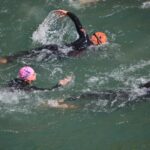Bad intensity—physical changes that hurt your triathlon—produces a wide variety of physical and mental “red flags” that can help you recognize when your intensity is too high or too low. By being aware of these signs, you can know when you’re not at prime intensity and can take steps to reach that ideal level.
Overintensity
Muscle tension and breathing difficulties are the most common signs of overintensity. Most triathletes indicate that when they’re too intense, they feel tension in their shoulders and legs, which happen to be the two most important physical areas for triathlon. For example, if a triathlete’s shoulders are tense, his swim stroke will be shortened, and less smooth and efficient.
Many triathletes also report that their breathing becomes short and choppy when they get nervous. This restriction in breathing means that they’re not getting enough oxygen into their system so they will tire quickly. I’ve also found that the smoothness of triathletes’ movements tends to mirror their breathing. If their breathing is long and smooth, their swimming stroke, pedal cadence, and running stride are fluid too. If their breathing is abrupt and choppy, their movements in the water, on the bike, and running are uneven too.
Triathletes who are overly intense often exhibit poor posture. Muscle tension causes their shoulders to rise and their body to close up. This change in posture is especially noticeable on the ride and run. Triathletes also often look rushed and frantic in the start and transition areas. They are moving so fast that they are actually slowing rather than accelerating their transitions.
Overintensity hurts triathletes mentally as well. Anxiety lowers confidence and causes doubts in ability. The physical and mental discomfort produces negative emotions such as frustration and despair. The anxiety, doubts, and negative emotions hurt focus by drawing triathletes’ attention away from performing their best and onto how badly they feel.
Underintensity
Though not as common, triathletes can also experience underintensity before races. Most often due to a lack of motivation to race, fatigue, or overconfidence, the most frequent symptoms of underintensity are low energy and lethargy. Triathletes lack the adrenaline they need to give their best effort. Though not as discomforting as overintensity, underintensity hurts as much because triathletes lack the physical requisites such as endurance and strength to meet the demands of a race.
Mentally, underintensity undermines motivation. Triathletes just don’t feel like being out there. The lack of interest caused by too low intensity also impairs their focus because they’re easily distracted and have difficulty staying focused on performing their best.




